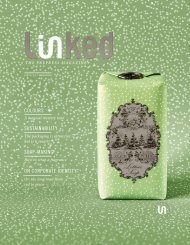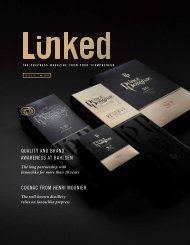Janoschka magazine Linked_V6_2021
You also want an ePaper? Increase the reach of your titles
YUMPU automatically turns print PDFs into web optimized ePapers that Google loves.
60
t o t e l l t h e t r u t h
issue #6 ©
l i n k e d
61
Do you know ...
which came first:
the match
or the lighter?
Night-time in the prairie. A lonesome cowboy casually strikes a match against the
heel of his boot and holds the flame to his cigarette until a glowing red dot
appears. This classic Western scene could never have happened without a chance
discovery by an English pharmacist.
To find out why, we’ll head to Stockton-on-Tees, England. The year is 1826. John Walker,
renowned throughout the town for his extravagant clothing and excellent education,
spent a lot of time conducting chemical experiments. This particular November evening
he was busy mixing antimony-sulphide (a sulphur compound) and potassium chlorate with
gum arabic and starch. We don’t know for sure what he was trying to achieve.
What we do know is that some of the thick paste remained stuck to the little wooden stick
he was using to stir it. Perhaps absent-mindedly, perhaps irritated, he tried to scrape off
the residue along a rough surface. Suddenly, it burst into flame.
He soon saw a practical use for his discovery. He had little wooden sticks
manufactured in the local poorhouse and dipped one end into his
chemical kindling mixture. He sold them in his pharmacy together with
a little piece of sandpaper and called them “friction lights“.
No risk – no light?
Wooden sticks soaked in sulphur were already
used more than a thousand years
ago in ancient China to light fires in fireplaces
and hearths. Not long after that they
came to Europe. However, to get these to
ignite, you needed a spark plus a smouldering
“tinder fungus“. Later, a type of match
was invented with a white phosphorus
and potassium chloride head that would
only ignite when it was dipped into sulfuric
acid. To call this method “playing with fire”
wouldn’t be an exaggeration, since you had
to carry a little bottle of this dangerous liquid
around with you.
Walker’s “friction lights” are based on a different
principle. To ignite the mixture on the
head of the stick, frictional heat was sufficient.
Unfortunately, he neglected to register
a patent for his invention and his matches
were in any case technically flawed. For
one thing, they ignited very easily and were
therefore dangerous; for another, the unevenly
flickering flame gave off a vile smell
of sulphur.
That was why the Londoner Samuel Jones
gave the name “Lucifer” to the product
for which he registered a patent in 1828,
having plagiarised Walker’s discovery.
John Walker’s idea fired imaginations all
over the world. Everywhere chemists
started playing around with different mixtures.
Some of them experimented with –
extremely poisonous – white phosphorus.
Later this was replaced by red phosphorus.
Eventually, around twenty years after
the first “friction light” had seen the light
of day, the ignition and friction substances
were separated, and the handy “safety
matches” that we know today were born.
Walker’s strike-anywhere matches have
not entirely disappeared, though. To this
day, one can light these “cowboy matches”
on any rough surface. They still have
the igniting component in their heads.









